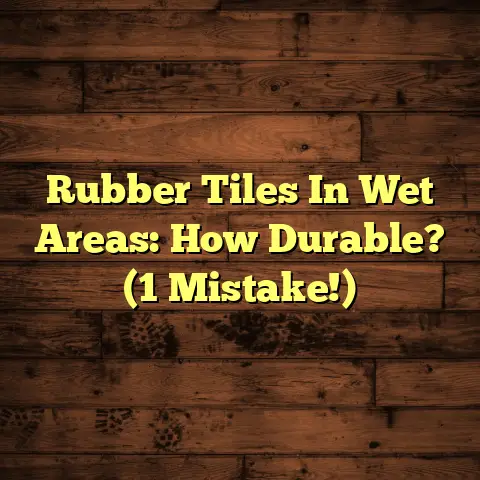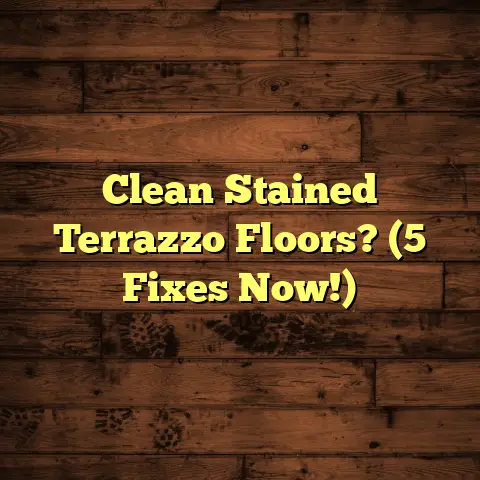Dilute Bleach For Floors? (3 Mistakes To Avoid!)
Ever walked into a home and been wowed by how sparkling clean the floors are?
Then walked into another where you just knew the floors had seen better days?
I’ve seen it all in my years as a flooring
contractor.
And let me tell you, a little
effort goes a long way!
Before Scene:
Imagine this: You walk into a living room.
The floors are dull, kinda sticky, and
you can see the grime clinging to the
edges.
A coffee stain from last month’s
movie night stubbornly refuses to budge.
There’s a faint, musty odor hanging in the air. The homeowner sighs, defeated.
“I just can’t seem to get these floors clean!”
Sound familiar?
I’ve been there myself,
and I know the frustration!
You want a clean, welcoming space, but the
floors are just not cooperating.
After Scene:
Now, picture this: You enter the same room.
But this time, the floors gleam!
They’re spotless, sanitized, and have a
fresh, clean scent.
The room feels brighter,
more inviting.
The homeowner beams with pride.
“I finally found a way to get my floors clean, and it’s so much easier than I thought!”
That’s the power of understanding how to properly clean your floors, and sometimes, that involves diluted bleach.
But, before you reach for that bottle of bleach, let’s dive into some crucial info!
Section 1: Understanding the Use of
Dilute Bleach for Floors
What exactly is diluted bleach?
It’s simply regular household bleach mixed with water to create a cleaning solution that’s less harsh but still effective at disinfecting.
The active ingredient in bleach is sodium hypochlorite (NaClO). It’s a powerful oxidizing agent.
That means it breaks down stains and kills
germs by disrupting their chemical
structure.
Think of it as a tiny wrecking
ball for dirt and bacteria!
Now, which floors can handle this diluted bleach magic?
- Tile: Porcelain and ceramic tile are
usually good to go.
They’re non-porous and can withstand the bleach. - Vinyl: Most vinyl floors are also bleach-friendly, but always test a small, inconspicuous area first.
- Concrete: Concrete floors can be cleaned with diluted bleach, especially in garages or basements.
But hold up! There are floors you should absolutely avoid using bleach on:
- Hardwood: Bleach can strip the finish,
discolor the wood, and cause irreversible
damage.
Trust me, I’ve seen the tears! - Laminate: Similar to hardwood, laminate is vulnerable to bleach damage.
- Natural Stone: Marble, granite, and other natural stones can be etched and discolored by bleach.
Why use bleach at all?
Well, according to
the CDC, bleach is highly effective at
killing a wide range of germs and bacteria,
including:
- Salmonella
- E. coli
- Staphylococcus aureus
Maintaining a clean home is so important, especially if you have kids or pets.
Diluted bleach can be a powerful tool in your cleaning arsenal, but only if used correctly!
Section 2: The Importance of Proper Dilution
Okay, so you’re thinking of using diluted
bleach.
Awesome!
But listen up, because
this is where things can go wrong fast.
Using bleach at full strength is a recipe for disaster.
I’ve seen floors that have been permanently discolored, finishes that have been stripped away, and even surfaces that have become etched and pitted.
It’s not pretty, and it’s definitely not something you want to experience.
So, what’s the magic ratio?
A general rule of thumb is to use a solution of 1 part bleach to 10 parts water. This is often referred to as a 1:10 dilution.
-
For example, if you’re using a gallon of water, you’d add about 1 1/4 cups of bleach.
- 1 Gallon = 16 cups
- 16 cups / 10 = 1.6 cups of water per 1 part bleach.
-
- 6 cups is approximately 1 1/4 cup.
Here’s a simple guide to help you measure:
Pro Tip: Always add the bleach to the
water, never the other way around.
This
helps prevent splattering and potential
chemical reactions.
Using too much bleach can lead to a whole host of problems, including:
- Damage to flooring materials: Bleach can corrode or discolor certain surfaces.
- Health hazards: Strong bleach fumes can irritate your lungs, eyes, and skin.
- Respiratory issues: Inhaling bleach fumes can trigger asthma attacks or other respiratory problems.
I remember one time, a homeowner called me
in a panic.
They had used full-strength
bleach on their vinyl floors, and the entire
surface had turned a sickly yellow color.
The fumes were so strong that they had to evacuate their house for several hours!
The moral of the story?
Dilution is key! Don’t underestimate the
power of a properly diluted bleach solution.
It’s safer for you, your family, and your
floors.
Section 3: Mistake #1 – Ignoring
Manufacturer Guidelines
Alright, you’ve got your diluted bleach
ready to go.
But before you start scrubbing,
there’s one crucial step you cannot skip:
Read the manufacturer’s guidelines for your specific flooring!
I can’t tell you how many times I’ve seen homeowners completely disregard these guidelines, only to end up with damaged floors and a whole lot of regret.
Every flooring material is different, and each one requires specific care.
What works for tile might be disastrous for vinyl, and what’s safe for concrete could ruin your hardwood.
Here are some examples of different flooring materials and their specific cleaning recommendations:
- Tile: Most tile manufacturers recommend
using a pH-neutral cleaner.
While diluted bleach can be used on some tile, it’s important to test a small area first. - Vinyl: Some vinyl manufacturers specifically advise against using bleach, as it can dull the finish or cause discoloration.
- Laminate: Laminate flooring is
particularly sensitive to moisture.
Manufacturers typically recommend using a damp mop and avoiding harsh chemicals like bleach. - Hardwood: As I mentioned earlier, bleach
is a big no-no for hardwood.
Most manufacturers recommend using a cleaner specifically designed for hardwood floors.
Where can you find these guidelines?
- Check the flooring manufacturer’s website.
- Look for the installation and care instructions that came with your flooring.
- Search online for specific cleaning recommendations for your flooring type.
Ignoring these guidelines can have serious consequences, including:
- Discoloration: Bleach can cause certain flooring materials to fade, yellow, or develop unsightly spots.
- Damage: Bleach can corrode or weaken the flooring surface, leading to cracks, chips, or other damage.
- Voiding warranties: If you use the wrong cleaning products, you could void your flooring warranty, leaving you on the hook for costly repairs.
I had a client who installed beautiful new vinyl floors in their kitchen.
They were so excited to keep them clean that they started using a strong bleach solution every week.
Within a few months, the floors had lost their shine and developed a strange, mottled pattern.
When they contacted the manufacturer, they
discovered that using bleach had voided their
warranty.
They were stuck with damaged floors
and no recourse.
Don’t let this happen to you!
Take the time to read and follow the
manufacturer’s guidelines.
It’s a small
investment of time that can save you a lot
of headaches (and money) in the long run.
Section 4: Mistake #2 – Using the Wrong Tools
So, you’ve got your diluted bleach, you’ve checked the manufacturer’s guidelines, and you’re ready to clean.
But hold on! Are you using the right tools for the job?
Using the wrong tools can be just as damaging as using the wrong cleaning solution.
I’ve seen homeowners use everything from steel wool to abrasive scrub brushes on their floors, thinking they’re getting a deeper clean.
But all they’re really doing is scratching and damaging the surface.
Here’s a rundown of common cleaning tools and their suitability for use with diluted bleach:
Mops:
- Microfiber mops: These are generally
safe for most flooring types.
They’re gentle, absorbent, and won’t scratch the surface. - Sponge mops: Sponge mops can be used on tile and vinyl, but avoid using them on more delicate surfaces like hardwood or laminate.
- String mops: String mops can be a bit
abrasive, so use them with caution.
Make sure the strings are soft and non-scratching. -
Scrub brushes:
-
Soft-bristled brushes: These are ideal for scrubbing grout lines or textured surfaces.
- Abrasive brushes: Avoid using abrasive brushes on most flooring types, as they can scratch and damage the surface.
-
Cloths:
-
Microfiber cloths: These are great for wiping up spills and cleaning small areas.
- Cotton cloths: Cotton cloths can also be used, but make sure they’re soft and non-linting.
- Microfiber mops: These are generally
safe for most flooring types.
The key is to choose tools that are gentle yet effective at applying the bleach solution without causing damage.
Avoid using anything that could scratch or degrade the flooring surface, such as:
- Steel wool
- Scouring pads
- Abrasive cleaners
I once saw a homeowner use a metal spatula
to scrape dried paint off their vinyl floors.
Needless to say, the floors were left with
deep, permanent scratches.
Using the wrong tools can not only damage your floors but also make the cleaning process less effective.
If you’re using an abrasive brush, you might be spreading dirt and grime around instead of actually removing it.
Here are some tips for choosing the right cleaning tools:
- Read the manufacturer’s recommendations for your flooring type.
- Choose tools that are specifically designed for cleaning floors.
- Test the tool on a small, inconspicuous area first to make sure it doesn’t cause any damage.
Investing in the right cleaning tools is an investment in the longevity and beauty of your floors.
Don’t skimp on quality when it comes to protecting your investment!
Section 5: Mistake #3 – Failing to Rinse Properly
Okay, you’ve diligently diluted your bleach, you’ve chosen the right tools, and you’ve scrubbed your floors clean.
But you’re not done yet!
There’s one more crucial step that many homeowners overlook:
Rinsing the floor thoroughly after cleaning with diluted bleach.
I can’t stress enough how important this
step is.
Skipping it can lead to a whole
host of problems, including:
- Residue build-up: Bleach residue can leave a sticky or dull film on your floors, attracting dirt and grime.
- Discoloration: Over time, bleach residue can cause certain flooring materials to yellow or fade.
- Health risks: Bleach residue can be harmful to your skin, especially for young children and pets.
I remember a client who complained that her tile floors always felt sticky, no matter how often she cleaned them.
After some investigation, I discovered that she was using a bleach solution to clean her floors but never rinsing them afterward.
The bleach residue had built up over time, creating a sticky, unpleasant surface.
So, how do you properly rinse your floors after cleaning with diluted bleach?
Here’s a step-by-step guide:
- Prepare a bucket of clean, warm water. Make sure the water is free of any cleaning solutions or chemicals.
- Use a clean mop or cloth to rinse the floor thoroughly. Wring out the mop or cloth frequently to avoid spreading dirty water around.
- Change the water frequently. As you rinse
the floor, the water will become dirty.
Change the water as needed to ensure that you’re removing all of the bleach residue. - Dry the floor with a clean towel or mop. This will help prevent water spots and streaks.
Here are some additional tips for rinsing your floors:
- Use a separate bucket and mop for rinsing than you used for cleaning.
- Rinse the floor at least twice to ensure that all of the bleach residue is removed.
- Pay special attention to corners and edges, where residue tends to accumulate.
Failing to rinse properly can negate all of your hard work and leave your floors looking worse than before you started.
Don’t skip this crucial step!
By taking the time to rinse your floors thoroughly, you’ll ensure that they’re truly clean, sanitized, and free of harmful residue.
Conclusion:
So, there you have it!
The inside scoop on
using diluted bleach for floors, and the
three biggest mistakes to avoid.
Let’s recap:
- Ignoring Manufacturer Guidelines: Always read and follow the manufacturer’s recommendations for your specific flooring type.
- Using the Wrong Tools: Choose gentle, non-abrasive tools that won’t scratch or damage the surface.
- Failing to Rinse Properly: Always rinse the floor thoroughly after cleaning with diluted bleach to remove residue.
Using diluted bleach correctly can be a safe and effective way to clean and sanitize your floors.
It can help you remove stubborn stains, kill harmful germs, and keep your home looking its best.
But it’s important to remember that bleach is a powerful chemical, and it should be used with caution.
By avoiding these three common mistakes, you can protect your floors, your health, and your peace of mind.
Taking pride in maintaining your floors is a great way to create a clean, healthy, and inviting living space.
With a little knowledge and effort, you can keep your floors looking their best for years to come.
So go ahead, tackle those dirty floors! You’ve got this!





